When Marcelo Bielsa joined Leeds United in June 2018, the move surprised football. Club Chairman Andrea Radrizzani was evidently proud of the work done by Director of Football Victor Orta and CEO Angus Kinnear in securing the Argentinian legend on a two year deal, and was effusive in how he felt this piece of recruitment could help the club evolve:
"He is a coach that I have admired for many years and when the opportunity arose to bring him to Elland Road, we made it our top priority for the summer.
Marcelo has a wealth of experience and he will use that to create a new culture and a winning mentality at our football club." (1)
Bielsa himself was characteristically modest about the challenges that lay ahead and his reason for joining the club:
"It has always been my ambition to work in England and I have had several opportunities to do so during my career, however I have always felt it was important to wait for the right project to come along and so when a club with Leeds United's history made me an offer, it was impossible to turn down...
I am excited for the challenge ahead."
What Bielsa has achieved since then has been nothing short of remarkable and he has delivered on his chairman’s words. Since relegation to the Championship in 2004, Leeds have suffered much instability and unrest but since the very first game that Bielsa helmed-- a 3-1 home victory against Stoke City--they have been pointing firmly upwards. A mid-table Championship side has been transformed into a Premier League club for 2020-21. StatsBomb are proud to have provided services to the club during the 2019-20 season and will continue to do so throughout the forthcoming year.
Let’s take a look at some of the analytical aspects that have led to the club finding it’s way back to the Premier League.
Quick impact, retained squad
The season before Bielsa was appointed, Leeds finished thirteenth in the Championship under first Thomas Christansen and then Paul Heckingbottom. This was the sixth time in eight seasons they had finished adrift in mid-table since being promoted out of League One in 2009-10. When decisions were made that summer, Heckingbottom hadn’t done enough in his short tenure to gain the backing of the board.
The core of the playing group that Bielsa inherited has been together a long time; indeed, nine senior players who featured heavily in the promotion run were at the club and regularly playing during that mid-table finish in 2017-18. Bielsa didn’t make wild changes to personnel; to start with he largely used what he already had.
As such, that first game against Stoke featured familiar names: Luke Ayling, Liam Cooper, Ezdzhan Alioski, Pablo Hernández, Kalvin Phillips, Stuart Dallas, Mateusz Klich and Jack Harrison were eight of the fourteen players that featured that day. During 2019-20 each of those players played more than 2000 minutes, while furthermore Gaetano Berardi, Barry Douglas and Adam Forshaw were also on the pitch that day and remained part of this squad nearly two years on.
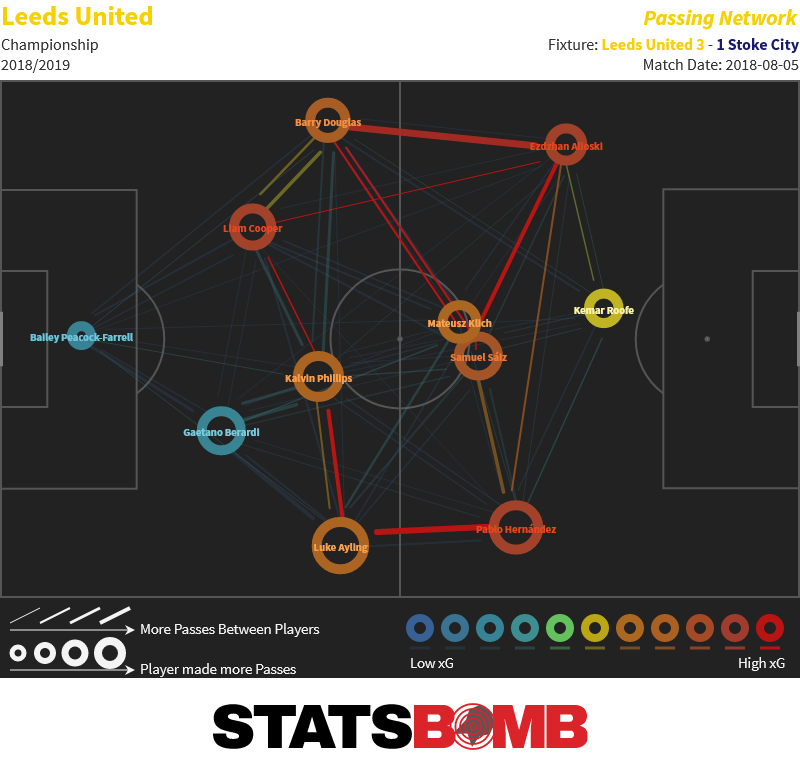
The associated cast brought in via the transfer market has been relatively cheaply assembled, especially when considering the somewhat profligate spending that can be associated with teams pushing to lift themselves out from the Championship. Patrick Bamford and Barry Douglas arrived for fees in the summer of 2018, but were mostly accompanied by loans. This was a trend that continued in 2019-20 with loanees Ben White and Hélder Costa the major new factors in the team, the latter on a loan-to-buy deal.
Improved metrics
Looking at metrics, Bielsa turned a mid-table, negative expected goal team into one with the league's best metrics.
It also happened very quickly.
Within his first ten games the team was recording close to 0.7xG per game more than their opponents. That is to say, their underlying performances were around seven goals better than the opposition. From that point onward, across two seasons, their metrics only really dipped once, going through January and February 2020, and they were still at worst worth three goals more than their opponents in any given ten game stretch.
At their strongest--through the crossover of 2018-19 to 2019-20 and beyond-- they were frequently posting metrics that were worth eleven or twelve goals more than their opponents across ten games. That early 2020 blip was the only time under Bielsa that the defence was offering up chances worth more than a goal per game, and coming out of that stretch they improved to a defensive level that was better than at any period prior. Team metrics have remained extremely strong across two seasons:
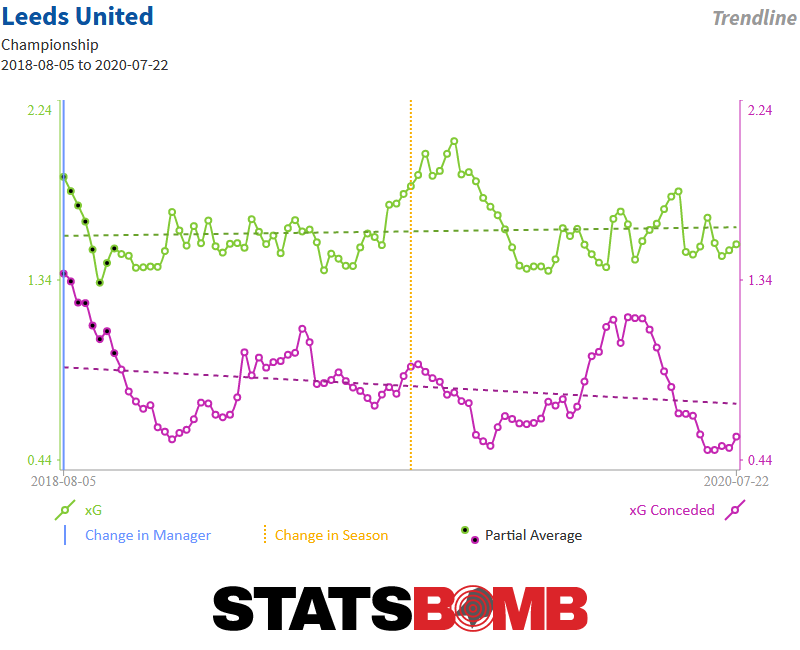
However expected metrics are not reality and the inevitable ebb and flow of variance around them did contribute to two divergent outcomes. Firstly, Leeds dropping out of the automatic promotion positions in 2018-19, in part due to a 10 goal swing against their expected metrics. Secondly, a similar positive swing, largely in their attack that cemented their promotion after the return from the lockdown break in 2019-20:
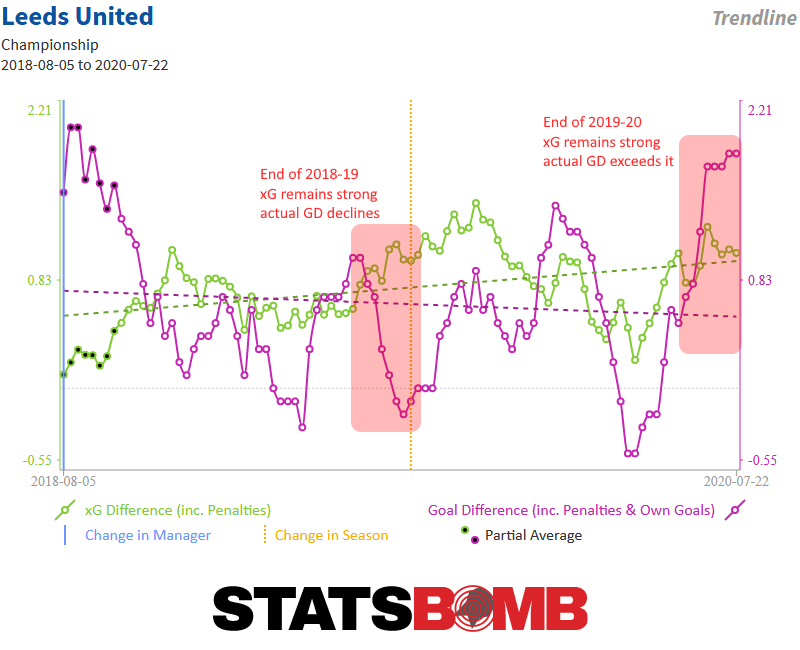
The drift out of the automatic promotion positions in 2018-19 led to a familiar narrative around Bielsa teams tiring at the end of seasons. Certainly the high energy style deployed by Leeds requires extremely high physical fitness levels, but the evidence in this scenario was far less concrete. While results dipped, general performance levels remained high. Also, when considering the shape of the 2018-19 Championship promotion battle, the circumstances around Leeds' rivals is worth scrutinising: Norwich City only lost two of their last 34 games while Sheffield United lost just two from 24.
By contrast, Leeds lost seven times between Christmas (although their overall form was still fourth best in the division) and ahead of a crucial and bizarre game they lost at home to Wigan on April 19th. At that point their fate was still in their own hands, and after an early red card for Wigan's Cedric Kipre was quickly followed by a Bamford goal, all looked well.
However, Leeds contrived to concede twice to the ten men by the hour mark, and despite a complete bombardment--15 shots in the last half an hour, 35 in total--they couldn't peg Wigan back.
After a defeat to Brentford in the next game, Bielsa was fairly shrewd in his judgment of the season as a whole:
“The level of the team has always been the same, the effort has always been the same. Of course the team has limits…This team has hidden many limits with huge effort. With personality, and by being demanding. Each player has played very close to his maximum during many games. “If we are to explain these circumstances, what we can say is this team deserves to have 10-12 points more and we don’t have them because we needed too many chances to actually score one goal. This is the vision I have through the whole season.” (2)
The freakish Wigan result ultimately tilted the promotion race in Sheffield United's favour while the Brentford result sealed it. Automatic promotion was out of their hands, with a play-off defeat to Frank Lampard's Derby an ironic coda to finish the season.
Goalkeeper woes
Leeds' non-penalty expected goals in attack across the whole of 2018-19 was best in the division at close to 71 goals, but matching this in goals scored was only enough to rank fifth. There is nothing intrinsically wrong with matching expected numbers, but teams that win titles frequently see them exceed expectation. That short term boost can make a huge difference and here each of the promoted teams exceeded expectation by reasonable margins.
In aggregate, it was the other end of the pitch that was more costly for Leeds as a negative defensive skew was large. In conceding 50 goals, Leeds allowed around 13 goals more than expectation. We can see where a majority of that came from if we just look at shots on target from range:
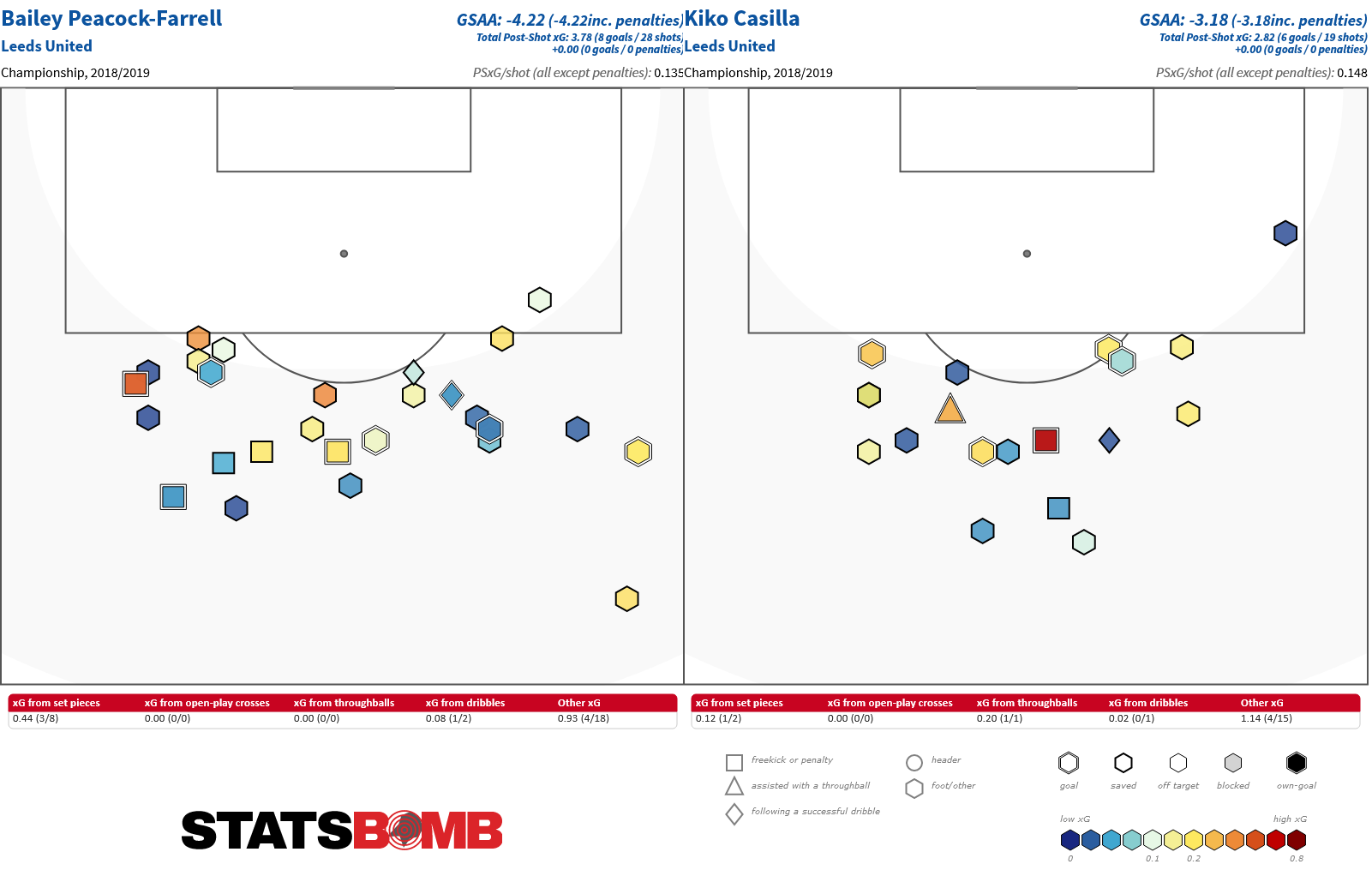
Bailey Peacock-Farrell conceded 8 goals from 28 shots on target at the range indicated in these charts, while Kiko Casilla conceded 6 from 19. We can forgive Casilla one goal here as Albert Adomah's goal for Villa was a literal gift and on review, in the main the shots he conceded were hard to keep out. Peacock-Farrell's tenure was less stable entirely and was littered with tame shots creeping in, slight fumbles or touches failing to keep the ball out. Only a miracle goal from Adam Reach for Sheffield Wednesday left the keeper entirely blameless.
Regardless of how this all occurred the facts remain stark. On aggregate, all shots on target are converted at around 30%. In 2018-19, Leeds' goalkeepers conceded shots on target at that rate just from long range shots. The mix of keeper error, deflections, good finishing and plain old luck essentially accounts for the vast majority of why Leeds struggled to limit opponent goals. From shots inside the box, Leeds allowed goals at a rate close to expectation.
To chime more directly with Bielsa's comments, we can look at how Leeds scored and allowed goals while the game was level. Across the whole of 2018-19, the worst deviation from expectation in the whole division occurred when Leeds were drawing games. In such circumstances, they outshot their opponents by nearly 150 shots yet scored just one more goal. The difference was valid at both ends; the attack scored close to five goals fewer than expected while the defence allowed 30 goals compared to an expectation of just over 19.
This is a classic representation of how from an analytics perspective, we can observe that the process is solid while the outcomes are more variable--in this case to Leeds' detriment. Knowing Leeds expected metrics were extremely strong in Bielsa's first season made the answer to the question "Could Leeds run it back?" easier to answer: providing they maintained their style in 2019-20, there was no reason why they couldn't.
Unique style
The change in style of play under Bielsa has created a degree of interest up and down the football league, even to the extent that one club, Huddersfield Town, have now employed one of his assistants, Carlos Corberán as Head Coach. It's worth asking, if a team can press with such vigour and achieve significant success, could other teams replicate the style? We can see via our opponent pass volume to defensive action (PPDA) charts that Leeds' style off the ball was like no other team in the Championship in 2018-19, indeed, like few other teams in world football:
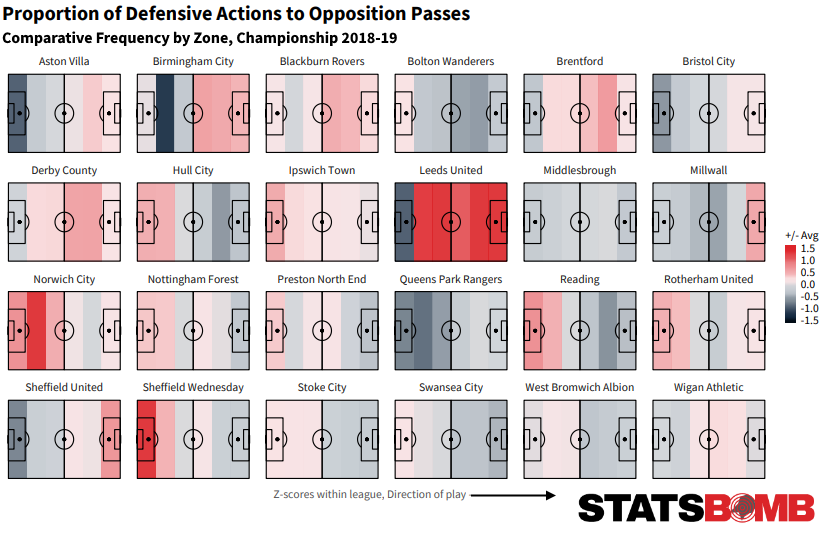
What you see here is a representation of proportional defensive activity with regard to opposition pass volumes. It allows us to compare each team and shows what a huge outlier Leeds were as soon as Bielsa arrived. They were hugely active in every zone of the pitch apart from near to their own goal. This profile is unusual. Usually high quality pressing teams (Liverpool, Manchester City) show as significantly active high up the pitch, Leeds cover nearly all of it.
You only have to watch Leeds for a couple of minutes to understand how they play and how it's different to many other teams. They press. A lot. Here we get a window into the role Patrick Bamford has played over the last two seasons too.
Through a combination of injury and selection, Bamford only began to start regularly in February 2019 but has ever since been the primary striker in Leeds' team. While his goalscoring woes are well documented (he scored 14 non-penalty goals from an xG of over 22.5 in 2019-20) the effort he puts into defensive work cannot be overlooked. In 2018-19, no forward in the league on average pressed as high, or had as high a percentage of pressure events in the opposition half (87%) and he ranked top three among forwards for a variety of other related metrics, all a clear uptick on Kemar Roofe who played much of the season in the role.
These metrics ticked slightly downwards across a fuller season in 2019-20, but nevertheless, that Bamford was the focal point of this team's attack in and out of possession was clear. The thing is though, everyone presses. Bamford leads the way high up the pitch. It is straightforward to see how this style has persisted season to season when we look at the same graphic as before for 2019-20:
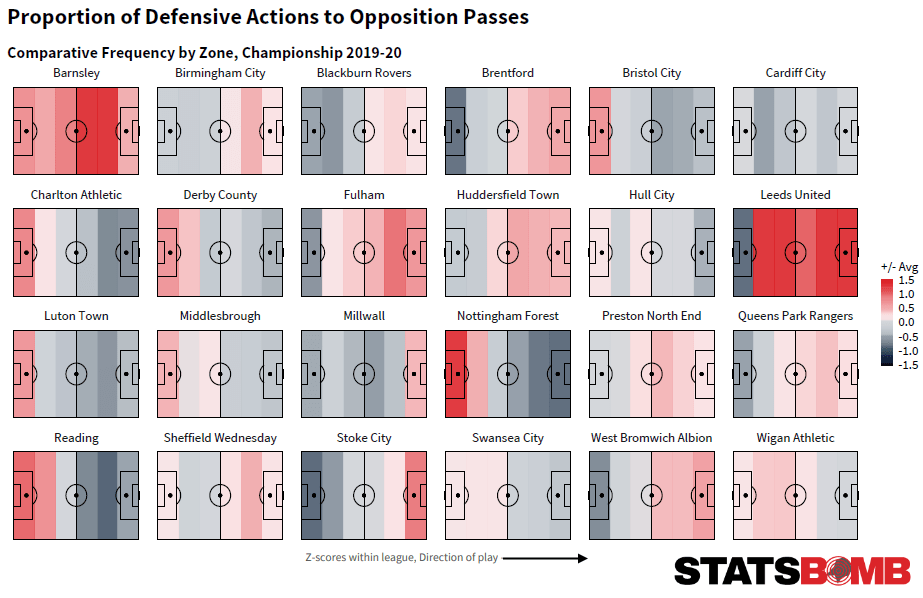
As an aside, such stylistic consistency does provide a clear pathway to recruitment. Though far less active overall, we can see particularly how Brentford's chart season to season displays this too. Across the entire 92 (91 in 2019-20) clubs in the Premier League and EFL, Leeds ranked second for "aggression" (defined as the percentage of opposition pass receipts faced by a pressure event or defensive action) in both seasons, marginally behind only Manchester City in 2018-19 and Barnsley in 2019-20. They actually slightly raised their volume here in 2019-20 from 29% to 30% too.
Defensive security
During the 2019-20 season, Leeds never dropped beneath fifth place in the table and after a win against Luton on the 19th November, they never finished a round of fixtures outside the top two. This time round, in the aggregate their attack again did not exceed expectation as Bamford's troubles anchored the output, but a huge seven own goals helped to traverse the finishing gap.
The defence saw the real turnaround and 35 goals against matched far closer to expectation than the negative skew of 2018-19. The Covid-induced interruption meant that the tail end of the season was delayed, but traversing it, Leeds' defence put in a truly stellar run. In winning five games before the break and seven of nine upon returning, Leeds gave up just five goals and an average of just over half a goal in xG per game.
Their opponents averaged under eight shots per game and those they took were of truly miserable average quality too. Quite often the weakness of a pressing team is in the quality of chances given up when teams do break through the press. Leeds under Bielsa have often combined low volumes of shots against (a clear perk for many pressing teams) without obviously sacrificing their ability to repress shot quality. This aspect will be hard to replicate in a higher league, but they could hardly have done better in their run in. They upped the ante and were defensively imperious, as we can see here;
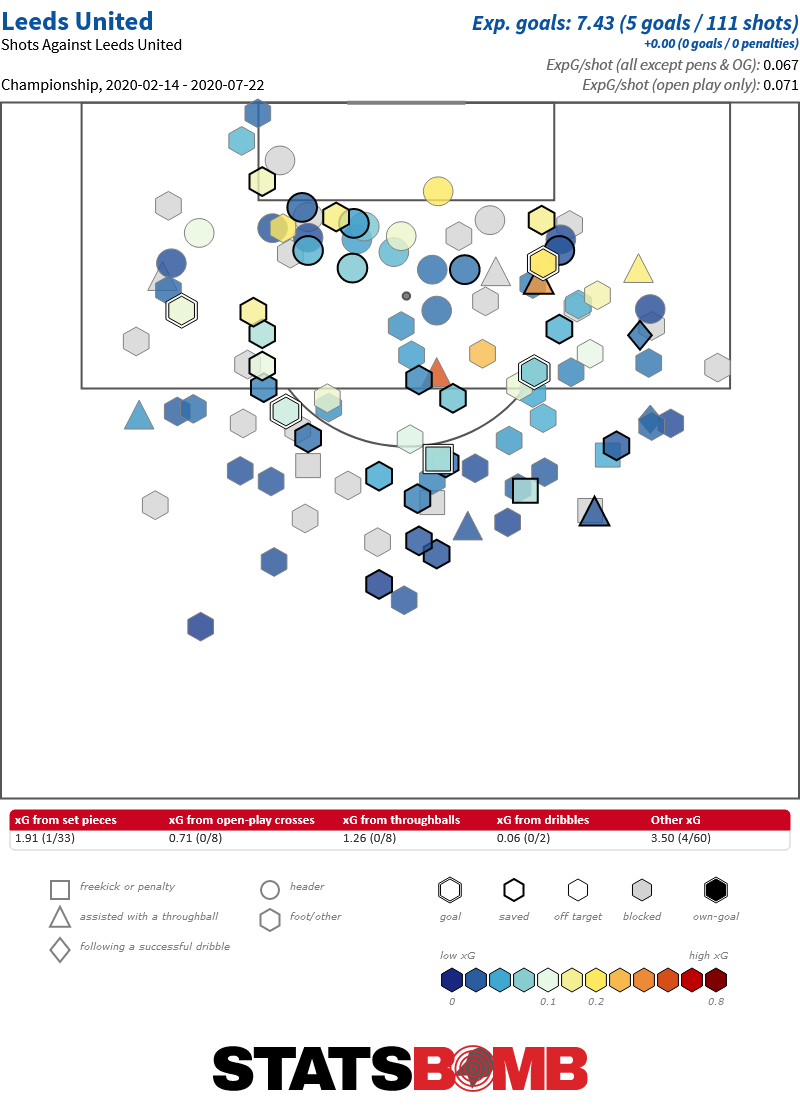
Some finishing luck? Yes, but look at the complete lack of high value chances (where is the red!), the paucity of good central footed shots (few hexagons!) and nearly nothing in the six yard box. Ironically, the only two goals Leeds have conceded from outside the box this season have come in this spell. This team waved goodbye to the Championship while hitting their full defensive stride.
As was then, is now
As we noted earlier, Bielsa's first fixture was at home to Stoke. A full 87 league matches and 704 days later, the same fixture recurred. Promotion was not yet certain and once again Leeds dominated the scoring, this time running out 5-0 victors. Yet if we compare the two pass networks from these two games, we can see how despite nearly two years having gone by, the way Leeds played, the positions their players took up and the overarching structure of the team had varied very little:
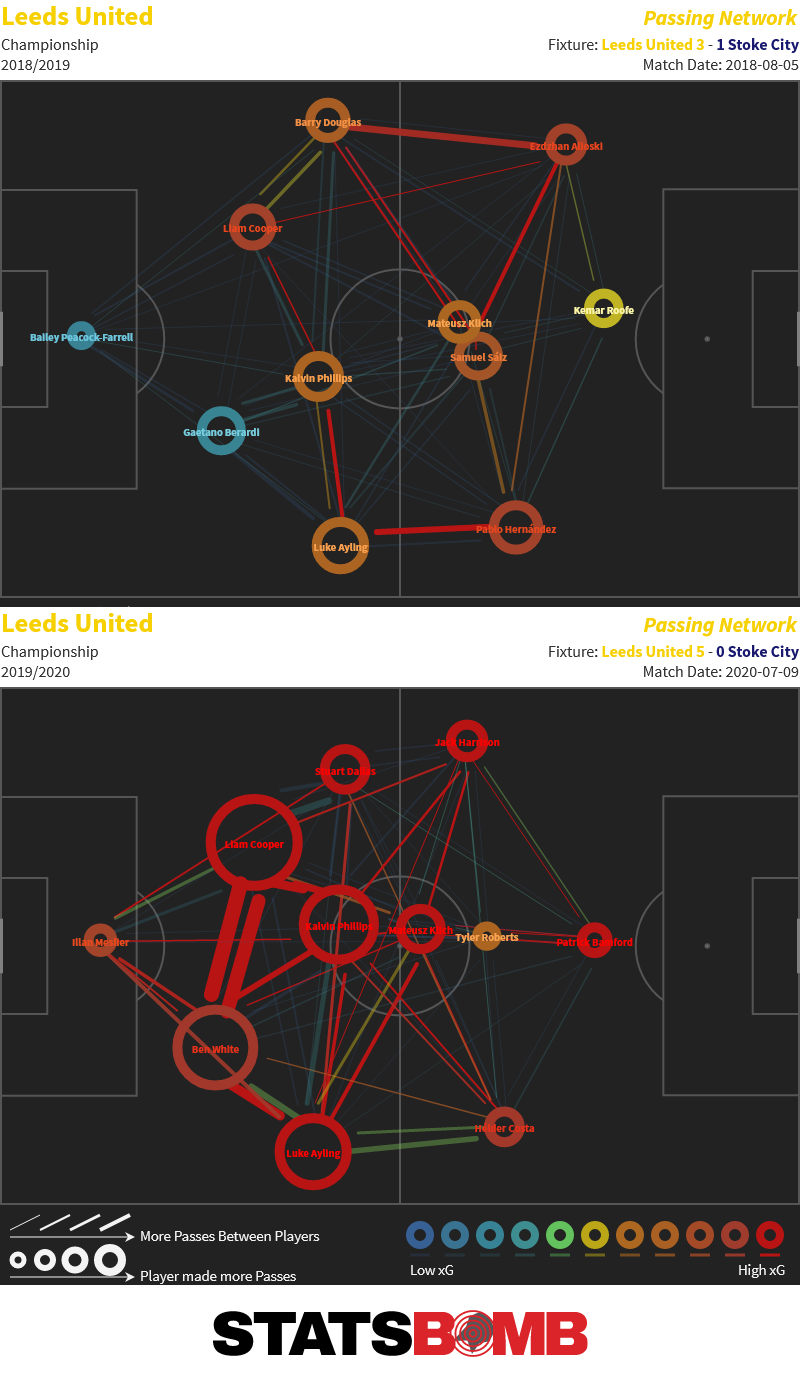
Perhaps, theoretically, the passing lanes have deeper grooves in them now... Leeds and Bielsa's success across the last two seasons is a rich chapter in a storied club's history. The Premier League now awaits, and few teams outside the top two are capable of playing a style anywhere near that which Bielsa demands of his team. Opponents will have to prepare for a hard workout. As a solitary reference point, the only time this Leeds team has faced Premier League opposition was an entertaining FA Cup tie against a strong Arsenal side.
They were very much second best in the second half and lost 1-0, but those who watched the game will recall the first half clearly. Leeds overwhelmed the Gunners for sheer energy and hustle and outshot them 15 to 3 without managing to breakthrough. Against weaker Premier League sides, that kind of play will bear dividends, and Leeds should be able to win a number of games this way. As well, a solid defensive record in a promotion season is quite often a portent for effective goal suppression in the Premier League, and Leeds have ticked that box.
They will need to beef out their squad but ideas around tiredness were not apparent in the broken up 2019-20 season and weren't entirely compelling the season prior. A shorter 38 game Premier League season will help here too, for all that it will be compressed. However the 2020-21 season progresses, few teams will be better physically and tactically prepared. The Premier League will be better for the presence of Bielsa's football and in particular matches against Pep Guardiola's Manchester City and Jürgen Klopp's Liverpool certainly whet the appetite. Leeds are back in the top flight, and they very much deserve to be.
If you're a club, media or gambling entity and want to know more about what StatsBomb can do for you, please contact us at Sales@StatsBomb.com
